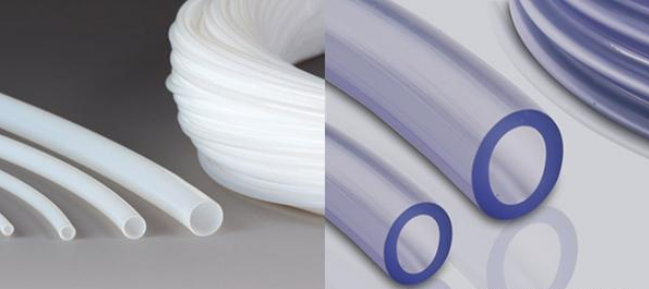In fluid transfer systems, hoses serve as the critical bridge between equipment and media, and their performance directly affects the stability and safety of the system PTFE hoses and PVC hoses, as two common types of hose materials, each have unique advantages and applications. Understanding the differences between them can help us make reasonable choices based on actual needs.

- Chemical composition and stability
The PTFE hose is made of polytetrafluoroethylene material, which has extremely high chemical stability and is almost unaffected by any substances. It can resist the attack of corrosive media such as acids, alkalis, and salts. Its molecular structure does not contain carbon-carbon double bonds so it has high oxidation resistance. In contrast, the PVC hose is a synthetic resin polymerized from vinyl chloride monomers. Although it also has good corrosion resistance its chemical stability and oxidation resistance are relatively lower. This difference makes the PTFE hose more advantageous in highly corrosive environments.

- Performance characteristics
PTFE hoses perform equally well in terms of performance. Their inner walls are smooth with a low friction coefficient, which can effectively reduce resistance duringance and decrease equipment wear. Additionally, PTFE hoses possess excellent high and low-temperature resistance, allowing them to operate stably in a wide temperature range -250℃ to 260℃ without becoming brittle or aging. On the other hand, PVC hoses, while having certain flexibility and tensile, are prone to deformation at high temperatures, limiting their use in high-temperature environments.

PTFE hoses, due to their excellent chemical stability, high temperature resistance, and wear resistance, are widely used in industries such as chemical, natural gas, food, and pharmaceuticals where high-performance piping materials are required. They are especially suitable for handling corrosive media and high-pressure environments. On other hand, PVC hoses, with their low cost and good processing performance, are extensively used in construction drainage, ventilation, water supply systems, as well as in and electronics fields where flexible installation and cost control are necessary. There are significant differences in material properties and application fields between the two.

In conclusion, we once again emphasize the uniqueness and complementarity of these two hose materials. PTFE hoses, with their excellent chemical stability low friction coefficient, and resistance to high and low temperatures, have become the preferred material for high-end manufacturing and extreme working conditions. On the other hand, PVC, with their cost-effectiveness and ease of processing, have found their place in a wide range of industries. The choice of which hose to use not only concerns-effectiveness but also the overall performance and safety of the system.
Media Contact
Company Name: Hainar Hydraulics Co,. Ltd.
Email: Send Email
Phone: 0086-13566050454
Address:A Building, No.39 Longtanshan Road
City: Ningbo 315800
Country: China
Website: https://www.hainarhydraulics.com/













